|
August 24, 2005
Mony Dojeiji and her 5000 km Walk for Peace
-
Part II
Here is part 2 of Mony's story who went from being a Microsoft
sales executive to completing a pilgrimage on the world-famous Camino
de Santiago, which made her decide to complete a 5000 km long Walk
for Peace for 13 months through 13 countries. Click
here to access part I of her fascinating story.
8. From Italy you continued on into the Balkan countries.
Please comment on your pilgrim experience there. I believe that
Croatia was a particularly unforgettable experience for you. Please
tell us about your experience in the other Balkan countries.
We walked through Slovenia, Croatia, Bosnia/Hercigovina, and Serbia/Montenegro.
Our experience in Croatia was the most intense. The people here
embraced us totally. We were in the newspapers and on television.
Their hospitality and desire to help us was incredible. Our message
seemed to resonate especially strongly here, in a country recovering
from their own war. It was also there that Alberto and I separated.
He walked ahead to Medugorje, in Bosnia/Hercigovina with the agreement
that I would only be a few days behind him. Medugorje is a village
in Bosnia/Hercigovina where it is said that the Virgin Mary appeared
to five young children about twenty years ago offering messages
of peace at a time when the country was strife with war. The messages
of peace continue to this day with a new message announced every
month. Alberto wanted to arrive for the next message while I couldn’t
walk that fast. We ended up being separated for over a month with
no way of contacting the other. We only managed to speak twice during
that entire time. He called me once to let me know that he had arrived
safely. And I managed to finally contact him, after days of failed
attempts, the evening before I was about to arrive in Medugorje.
Circumstances seemed to conspire to keep us apart. I fell ill a
few days after we separated with an infection of the lymph nodes
under my arms. I was told I may need surgery to drain them since
they were badly infected and the doctor didn’t know if the
antibiotics would be strong enough. In the end, they did work but
I needed over two weeks to recover from it and to regain the strength
to walk again. I was taken care of and welcomed by an incredible
community in Brodarica where the priest of the local church took
me into his home, brought me to doctors and medicine, and where
the nuns there oversaw every step of my recovery. They appeared
as angels in my way to help me at a time when I was alone.
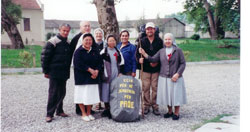
Money in Albania
That experience of being looked after and protected on my way gave
me the confidence to continue walking alone. For Alberto as well,
it was important for him to know that he can walk without me. We
always felt more confident together knowing that a couple would
be accepted easily and given accommodations. It was more difficult
for people to trust in a young man walking alone and give him accommodations.
His experiences were not always easy but he found angels along his
way, just as I did, who stepped in and helped him when he needed
it most. It was a valuable lesson for us being apart and one that
reminded us that we enjoyed walking together but we didn’t
need to do it. We would always be taken care of.
9. After the Balkan countries you went through Greece to
Turkey. Please comment on this portion of the trip. What made the
Turkey portion unique and different?
The Turkey portion was unique for several reasons. Physically,
we were walking in Turkey in the summer, in temperatures of well
over 40 degrees Celsius every day. We started walking at 5:00 in
the morning so that we could finish by 10:00 at the latest, before
it became too hot. The heat sapped all our energy and left us feeling
drained most of the time. Emotionally, we had also started our romantic
relationship. It had started at the end of Greece but intensified
in Turkey. As in every new relationship, it brought out the best
and worst in both of us. Culturally, we had left the Christian world
and entered fully into the Muslim one. All of these factors combined
made us turn more inwards, to focus more on ourselves and to only
see only the negative in our situation. As a result, we attracted
more negative experiences that directly reflected our beliefs. Because
of judgments that we had about the Muslim world being more conservative
and un-accepting of two single people walking together, we didn’t
seek help in mosques, nor did we try to engage people as we did
earlier in our walk. We were walking along the touristy Turkish
coast, and felt that people saw us more as tourists than as pilgrims,
and didn’t really care about our message or what we were doing.
We felt they were more interested in our dollar value than in our
true intentions. So of course, we attracted exactly the situations
that reinforced those beliefs. It was an incredible lesson in watching
how our thoughts and beliefs directly influenced what we attracting
into our lives. It was exactly as we had been saying all along –
we had the power to change the world through our thoughts and intentions.
Once we saw what was happening, we could step away from it and try
to heal the prejudices and misconceptions that we had about this
world. It was when we did this that our experiences totally turned
around and we were finally able to see the true heart of the Turkish
people.
10. Please comment on the final portion of your route.
How did you get to Jerusalem? You also referred to a unique coincidence
(that maybe wasn't so coincidental at all) related to the 12 gates
of Jerusalem. Please comment on some of the other "coincidences"
you experienced on this trip.
The final portion of our trip was into the Arab world. We walked
through Syria, Lebanon and Israel. The Lebanese-Israeli border was
the only border we could not cross on foot. It was physically closed
with land mines and barbed wire blocking our way. We had to take
a plane from Beirut to Cyprus, then to Tel Aviv. From there, we
took the train north to Haifa to begin our walk again. We were deeply
frustrated by this because we really felt the message of peace needed
to cross at this specific border, site of so many hostilities and
conflicts. But it wasn’t meant to be. From Haifa, we continued
along the coast, then cut inland towards Jerusalem.
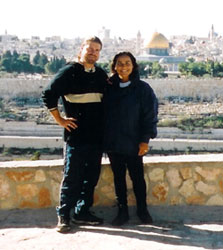
Mony and Alberto in Jerusalem
Our entire pilgrimage was a series of synchronicities, coincidences,
and people arriving when we needed help. We do not believe in coincidences,
but that all has a Higher Purpose which often eludes us, but that
is always for the greatest good of all involved. We arrived in Jerusalem
on December 24, 2003, Christmas Eve, completely unplanned. We walked
to the old part of the city, which is surrounded by high ancient
walls. We knew there were twelve gates, not all open, and decided
to simply follow the road that led to the first gate on the way.
We found ourselves in front of a huge arch called Bab Al Khalil,
the Gate of Khalil. An Arab friend we had met during our walk had
told us that the name Khalil meant Albert in English (or Alberto
in Spanish). So after thirteen months of walking, we entered the
Old City of Jerusalem through Alberto’s Gate! We were also
fortunate enough to be able to go to Bethlehem that very evening
and to be in the city where it all started. In a way, we were coming
back to the beginning.
We also had another unusual coincidence during the last leg of
our pilgrimage. During the entire walk, we always carried signs
announcing what we were doing. In Israel, our signs said the word
Peace in English, Arabic (Salam) and Hebrew (Shalom). The very day
that we put on the signs, the letters started to fall off as we
were walking. We tried to paste them on again, but it didn’t
work. It was as if we weren’t meant to carry this sign to
its final destination. It was a difficult thing to accept because
for me especially, I felt this was where the sign was most needed.
But upon later reflection, we realized that the outward message
of peace had served its purpose. It had touched those who needed
it. But now it was time for us to go inward, to focus on the inner
journey of peace, to bring that energy into Jerusalem with us. We
realized that the only way to bring peace into such a troubled area
was not to shout it from the rooftops, but to live it in our everyday
lives, in our actions towards the people who are like us and unlike
us. The work of peace is an inner journey, people changing themselves
and their attitudes and beliefs about their neighbors and the world
they live in. They can then come to the world from this place of
peace, acceptance, tolerance and openness. When they can be that
peace that they wish to see, is when they can affect the most incredible
change. When they can see the other point of view, when they can
forgive themselves and their neighbors for their mutual acts of
atrocity, when they can truly listen and have compassion for the
other, that’s when true peace can be created.
11. Please tell us about your experience once in Israel.
What places did you visit, what thoughts went through your head?
We really didn’t venture very much outside Jerusalem itself.
We were only able to enter Bethlehem on Christmas Eve because the
Israeli government had given permission to allow tourists and pilgrims
to enter on Christmas Eve and Christmas Day. Normally, the city
is barricaded and access is limited or completely restricted. We
felt very fortunate to have been able to enter. Likewise with the
West Bank and Gaza. There was no way to enter. We also wanted to
experience first-hand what life was like here. In Bethlehem, we
had the Palestinian experience. In Jerusalem (and on our walk from
Haifa to Jerusalem), we lived the Israeli experience. It’s
easier to understand the Palestinian experience because it’s
what we’re most exposed to in the media.
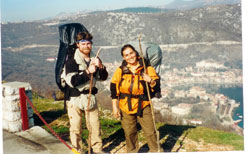
Mony and Alberto
There is no question we felt the hopelessness, the helplessness
and the pain of the Palestinian people. But what most opened our
eyes was the Israeli experience. I was accustomed to seeing only
one face of the Israeli people, that of the aggressors. What we
saw was that they were also victims of their choices, hostage to
their fears, allowing those fears to rule every aspect of their
life. Young men and women, most under the age of twenty, were walking
around with machine guns patrolling squares and open areas. On the
trains, on the buses, machine guns were in full sight. We couldn’t
walk into any restaurant, shopping center or public place without
being submitted to a search of our bags and metal detectors. Even
walking into a McDonald’s, we had to clear security. In the
old city of Jerusalem, police with full body armor patrolled the
streets. I kept thinking, this is not normal. They’re putting
on a face of normalcy on a situation that is clearly not normal.
Like their Palestinian counterparts, they were living in terror
and under the constant pressure of being blown up just by going
about their daily lives. They’re equally convinced that all
Palestinians want them dead, as of course the Palestinians think
of the Israelis. Their political choices reflect this deep fear
and paranoia. One journalist described the situation as ‘shoot
and cry’ and then ‘vote and cry’. It seemed an
apt description. For the first time, I felt the pain and sadness
of the Israeli people and understood that they only allowed their
leadership to act as it did not out of a desire for revenge or to
obliterate the Palestinian people, but out of the deep terror that
if they don’t defend themselves and attack first, they will
be killed. As in many situations, their aggression was masking a
much deeper fear.
What gave me incredible hope, and what the media does not report
on, are the ordinary people, Israelis and Arabs, working for peace
together. There are many Israelis and foreign observers putting
their lives on the line, acting as human shields to protect Palestinians
as they go about their daily lives. There are so many peace organizations
working to bring about change at every level, social, political,
cultural and religious. We read stories of ordinary people defying
stereotypes and getting to know their neighbor, often united in
their losses, in their grief, but also in their hopes for their
children. There were daily protests by mothers, grandmothers, and
all those who have lost loved ones and were seeking change. Young
Israeli reservists refusing to do military duty and facing imprisonment
and severe sentences. This is the face that most people do not see
and what left such a deep impression on us.
12. What are your 3 most significant memories from this
5000 km Walk for Peace?
It’s difficult to choose only three, but I can summarize
the impressions that stand out most in my mind. I think often of
the kindness and generosity of ordinary people in every single country
we walked in, people who didn’t speak our languages, but who
through their simple acts of humanity touched us and helped us on
our way. Often, they were people who had nothing and yet shared
all that they had. I am touched when I think of the look in peoples’
eyes when they heard about what we were doing, and the emotion and
the hope that our walk seemed to inspire in them. We know we touched
many people simply by walking past them, and often by putting the
power to create change in their world back in their hands, reminding
them of their innate power and the significance of what they see
as simple acts.
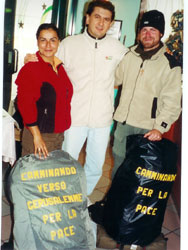
Mony, announcing her Walk for Peace in Italian
Above all, I can’t help but marvel at the incredible synchronicities
of this entire pilgrimage, the people showing up just when we needed
them, circumstances revealing themselves to make our path easier.
This is not to say that all our experiences were easy and that we
didn’t pass any difficult moments. We did, but in every experience
was hidden a marvelous lesson waiting to be revealed.
13. How has this experience transformed you personally?
I trust more in the goodness of people. I am more patient with
myself and others. I don’t see people quite as separate from
me as I did before. I see our similarities, our hopes, our dreams,
more than I see the differences in our languages, cultures, and
religions. I find I’m not so quick to judge others, having
been judged myself often as many things – a wanderer, a poor
vagabond, an idealist, a dreamer, someone naïve who doesn’t
understand the real world and the complexities of peace. I have
more faith and trust in the unknown, whether you call it God, the
Universe, the angels. The label doesn’t matter. It’s
all the same creative, loving energy that guides each of us to our
higher purpose, when we open ourselves to it. I have more confidence
in the world and in ordinary people making change happen. I see
our world changing for the better. There is a higher consciousness
that is growing daily of ordinary people like you and me choosing
to live lives with meaning and to contribute something positive
to the world. Despite all we see on television, which only presents
a part of the story, I have more hope for the future.
14. What has happened after you finished your walk for
peace? Today you live in Spain. Please tell us about your life in
Spain. What do you enjoy about your new home town?
After our pilgrimage, we came to Spain for Alberto’s family
to meet me, and then to Canada for my family to meet him. We married
in 2003 and had our daughter Sylvana in December of that year.
We are still trying to live the lessons of our pilgrimage in our
everyday lives, in how we deal with people and situations. We try
to look for the light in every person, not their dark. We know we
create situations so whenever something happens that we don’t
want, we look at ourselves and not at others. We try to let life
unfold as opposed to controlling it, forcing it or rushing it along.
It’s difficult to do this in a ‘normal’ world
and often we forget everything we’ve learned, but that remains
our intention. Fortunately, we live in the deep south of Spain in
an area that’s very laid back and where people are open and
friendly. The pace of life here is more relaxed, there’s more
focus on quality of life as opposed to pursuit of success and material
wealth. It’s small enough that we can walk everywhere for
all our needs – shopping, banks, doctors, pharmacies. We only
just bought a car so that we could travel outside the city and explore
the beauty of Andalusia and the rest of Spain and Europe. There’s
a focus on family and community which we really appreciate. Families
go out with their children everywhere – restaurants, cafes
at all hours. It’s common to see strollers with children sleeping
in them at midnight. Children are a part of the family’s life
and of the social experience. Children learn to adapt to the family’s
lifestyle, not the other way around. We’re learning a great
deal from this way of life and are adapting very easily.
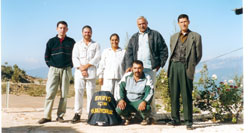
Mony in Turkey
15. Following this monumental Walk for Peace, what are
your plans for the future? How do you intend to integrate this experience
into your life from here on in?
We are currently writing a book of our experiences and hoping
to have it published late this year or early next year. Our intention
is to share the many lessons that we have learned from our pilgrimage
with others in the hopes that they are inspired to pursue their
dreams and passions. In a way, a pilgrimage is a way of life, it’s
not something that ends. It has no beginning or end. It is a continual
journey of self-discovery and transformation. And that’s what
life really is, for those who choose to embrace change as part of
their life. So our pilgrimage continues. We continue to accept and
heal. We continue to shed and embrace. We continue to grow and learn.
We are attempting to create peace in our world by being that peace
in our daily lives, and are trying to bring that into the life of
our daughter, so that she is surrounded by that positive energy
and grows with the absolute knowledge of her power to change herself
and her world, and the confidence to face her fears squarely and
follow her dreams and passions.
Mony, thank you so much for your time in describing to us this
fundamental transforming experience that took you from a high-powered
corporate position in Canada through 13 countries to a more tranquil
family life in Spain. We wish you all the best for finishing your
book!
Related Artices:
Mony Dojeiji and her 5000 km Walk for Peace -
Part I
Sue Kenney and her pilgrimage
on the Camino de Santiago
On a day that I played hooky from the office I realized that Sue and
I are kindred spirits
Read Danielle's story who
together with her husband mortgaged her home to start a non-profit
community development project to help a Peruvian town in need
|